
- Subscribe Now
- Digital Editions
- Latest Issue
- The Country Life Podcast
- Country Life's Little Black Book

Australia House: The story of Australia’s unforgettable outpost in the heart of London
An imposing home for the newly federated Commonwealth of Australia sought through its design and materials to celebrate themes of union with Britain and national self worth, as Prof G. A. Bremner explains.
Once seen, Australia House — occupying the eastern point of the Aldwych island site on the Strand — is not easily forgotten. Unlike the rambling Gothic pile of the Royal Courts of Justice by George Edmund Street nearby, it is not a huge building. Its powerfully articulated façade, conspicuously paraded on three sides, nevertheless makes for an impression that belies its stature. This attention-seeking demeanour, as it were, was intentional. Designed in 1911 by the Scottish architectural partnership of Alexander Marshall Mackenzie and his son, Alexander George Robertson, Australia House was designated the home of the High Commission of the recently federated Commonwealth of Australia (1901).
The architects’ goal was to create a building, ‘architecturally worthy of the headquarters of the Commonwealth in the capital of the Empire’. Being a newly independent Dominion, Australia was, indeed, keen to make its presence felt in the Imperial capital. The youthful nation believed it had much to offer and saw a magisterial piece of architecture as an effective way of advertising its importance to the continued primacy and economic prosperity of Greater Britain on the world stage. This was an entirely fitting aspiration, as the events of the First World War would prove.

Fig 2: The High Commissioner’s panelled study occupies the front of the building. Australia House, London. Credit: Will Pryce for Country Life
By the time of the building’s completion and official opening in August 1918, the fledgling nation of Australia had voluntarily answered the call of ‘King and Country’. Having made huge sacrifices towards the Allied victory, Australia had proven its loyalty and Australia House stood as a grandiose emblem of its steadfast allegiance. The great bronze sculpture of Phoebus Driving the Horses of the Sun by the Australian sculptor Bertram Mackennal was yet to take pride of place above the main entrance, but, as the Architectural Review opined, there could hardly have been a more fitting subject in ‘this day of the fame of the Australian soldier and his crest of the Rising Sun’.
Planning the building was no straightforward task. As Australia had been six independent crown colonies before federation, a degree of rivalry existed between them. Indeed, even following political union, these states — as they became — jealously guarded their limited independence and sense of identity. This created a tension in the requirement of each state to be represented in the building, with their own office space. This was exacerbated by the fact that the government of Victoria already had its own premises at the south-west corner of the site (Victoria House), built in 1909. Tall and slender, this building was designed by Alfred Burr, with the assistance of Norman Shaw, in a heavily rusticated Baroque Classicism. It had been envisaged as the first instalment of a much larger building encompassing the other Australian states. But, with a change of strategy, it presented something of a challenge, both politically and architecturally. Ultimately, the problem was solved by removing the existing gable and turret and remodelling the roof, enabling its seamless integration with the new and larger Australia House.
Recommended videos for you

Fig 3: The exterior of Australia House. Bertram Mackennal’s Phoebus sculpture presides over the entrance, which is flanked by the ‘Prosperity’ and ‘Awakening’ of Australia. Credit: John Goodall for Country Life
The exterior of Australia House ( Fig 3 ) is of Portland stone, on a base of light-grey trachyte from Mount Gibraltar in New South Wales. The tripartite division of rusticated lower section, rising through coupled giant-order columns, up to a strong entablature with projecting cornice, is topped with a mansard roof decorated with elaborately worked copper ridge caping and mouldings. As a whole, the ensemble makes for what was described in the architectural press at the time as a building ‘full of masculine strength and vitality’.
Such parlance was understood as signalling an architecture of intent and one replete with wider political connotation. Indeed, the combination of materials was itself significant in this regard, capturing symbolically the idea of common bond: Australia, once a collection of separate crown colonies, now independent, still cleaves happily to the ‘mother country’ in supporting shared cultural and political values. Moreover, trachyte was a stone commonly employed in Italy during the time of the Roman Empire. Thus, combined with a style of architecture described by the architects as ‘Roman’, the building certainly struck something of an imperial chord. In this sense, Australia House was a masterstroke of architectural diplomacy, at once a statement of national self worth and symbol of cooperation and union.

Fig 4: The top-lit, glass-covered rotunda opens into the main vestibule below, serving to draw the eye upwards on entering the building. Credit: Will Pryce for Country Life
The pairing of British and Australian materials on the exterior is carried through inside. As visitors enter the building, they are greeted by a magnificent, elongated vestibule ( Fig 7 ) , beyond which lies a large space that once served as an exhibition hall ( Fig 1 ) . Both spaces are lavishly decked in 1,200 tons of veined and mottled Australian marbles from Buchan in Gippsland, Victoria, and Caleula in New South Wales. This marble has been beautifully worked by H. G. Jenkins & Sons of Torquay in the same, ebullient style of Classical architecture as the exterior. Its effect is marvellously enhanced through gilding and a considerable amount of bronze decoration in the form of metopes and rosettes, wreaths and trophies.
Visible here, too, are Roman shields, continuing the imperial theme from outside. In the trophies can be identified devices referent of Australian industry, such as mining picks and heads of wheat; whereas the triglyphs in the frieze surrounding the hall depict rams’ heads representative of one of early Australia’s greatest industries, wool. The keen eye will also spot other flora and fauna indicative of the country, including grapes and pearls, not to mention the kangaroo and emu, which appear on the Australian coat of arms. Indeed, Australian plants and animals are found poking out from behind almost every corner.
The public concourse — including vestibule, main stair ( Fig 5 ) and hall — was illustrative of the abundance and fecundity of this resource-rich land. As potential immigrants and entrepreneurs came to view the exhibits and absorb their tale of antipodean opportunity, the surrounding architecture did its silent, but persuasive work. So impressive was this space that it was considered at the time to be one of the finest of its type in the country.

Fig 5: The sinuous curves of the impressive main stair and its balcony landing. Credit: Will Pryce for Country Life
Opening directly above the vestibule area, on the first storey, is a glass-covered rotunda ( Fig 4 ) , drawing the eye up almost immediately as one enters the building. Apart from shedding light deep into the space beneath, this rotunda acts as a transitionary zone between the High Commissioner’s office ( Fig 2 ) , at the very front of the building, and the library-cum-conference room above the exhibition hall. The latter of these two spaces, stately in appearance, is large and quadrangular in shape. As in the hall beneath, it is decorated with Caleula marble columns, only this time in pilaster form with gilt capitals ( Fig 6 ) .
The timber panelling, as with nearly all the timberwork in the building, comprises native Australian wood, in this case Moreton Bay chestnut ( Castanospermum australe ), prized for its swarthy and grained appearance. The interiors of the building are also characterised by extensive use of metal and bronze componentry, such as doors, windows and balustrading, including that on the stairs and around the rotunda. In the upper levels and on the stairs, extensive use has been made of the distinctive creamy-white marble from Angaston in South Australia.
The metalwork emphasises the ‘French’ element of the design, broadly reflecting Louis XIV taste. It also provides further opportunity for ornament, with symbolism appropriate to the building’s purpose and meaning woven through. On the rotunda balustrading, for example, one can find gilt-bronze motifs of the seven-point star, which appears on the Australian flag (and coat of arms), surrounded by heads of wheat; whereas above the main entrance door in iron is positioned a gilt-bronze trophy modelled with a winged head of Minerva surrounded, among other things, by floral motifs depicting Australia’s emblematic native plant, the wattle.

Fig 6: Panelling and Caleula marble columns in the library-cum-conference room. Credit: Will Pryce for Country Life
Although the architecture is distinctly historical in style, the building represented thoroughly modern construction. Built by Dove Brothers of Islington, it is of steel frame with hollow brick and reinforced concrete flooring, which, by the end of the first decade of the 20th century, was becoming standard for large building projects in London. Electric lighting and inter-office telephone communications were installed throughout. In addition, two Waygood-Otis electric passenger lifts were installed, with a speed of 300ft per minute. An innovative system of heating the building was also fitted. This ‘panel’ system was effectively hidden from view behind the marble and plaster walls and skirting, from which heat radiated. The total cost of the building, as one might expect, was high, coming in at about £1 million (roughly £57 million in today’s money).
Returning to the exterior, we find the main entrance flanked by two large and conspicuous groups of sculpture. These are by the British-born Australian sculptor Harold Parker, who, upon returning to his homeland in 1896, worked with the likes of Hamo Thornycroft and Thomas Brock. The groups, executed between 1915 and 1918, are very much in the so-called New Sculpture style of the period, and depict (left, facing the entrance) The Prosperity of Australia and (right) The Awakening of Australia .
These are both pyramidal compositions, with leading female allegorical figures. The figure representing ‘prosperity’ is seated, with right arm outstretched and left holding a dove to her chest. With a cornucopia positioned directly beneath her outstretched arm, the idea would appear to be that Australia is a land of peace and plenty. The masculine figures below hold the fleece of a ram and a sheaf of wheat, indicative of Australia’s primary industries. The opposing group is represented by a youthful woman rising as if from slumber, shedding her night attire and stretching her limbs. The symbolism is clear; beneath are positioned a dying explorer and his companion (holding a map), representative of the opening up of the Australian interior or ‘outback’.

Fig 7: The entrance vestibule looking towards the door, with rotunda above. Credit: Will Pryce for Country Life
Later, in 1923, would come the magnificent Phoebus Driving the Horses of the Sun by Mackennal, Australia’s most eminent sculptor working in London during the period, placed high on the cornice above the main entrance. Here, it faces along the Strand and Fleet Street, a prominent feature of the Imperial ceremonial route — recently improved by the realignment of the Mall — that stretched from St Paul’s Cathedral to Buckingham Palace.
Australia House was widely acclaimed as a successful building and it remains the home of the Australian High Commission to this day. The model it presented at the time was replicated by Britain’s other leading colonial Dominions and territories. Nearby, on the same Aldwych island site, rose India House (1926–30), to designs by Herbert Baker. Not long after would appear South Africa House (1931–33), on Trafalgar Square, also designed by Baker (with Alexander Thomson Scott). Across from it, on the other side of Trafalgar Square, the Canadian government acquired the original premises of the Union Club and Royal College of Physicians, completing a refurbishment in 1925 to house the Canadian High Commission.
As subsequent events have shown, what this sequence of ‘dominion houses’ signalled, in fact, was the slow, but steady decolonisation of the British Empire, the first step in what would ultimately become the British Commonwealth of Nations we know today. In this sense, Australia House is an historical monument, as well as an architectural one.
Curious Questions: Why do Australians call the British ‘Poms’?
With England about to take on Australia in The Ashes, Martin Fone ponders the derivation of the Aussies nickname for
How the St James’s Park pelicans sparked a Cold War stand-off between Russia and the USA
Former diplomat Alistair Kerr tells the strange tale of the pelicans that live in the centre of London – and how
Why do we all want to live in the countryside?
It's in our DNA.
Cluny Castle: Granite, grandeur, and testimony to the exceptional wealth of its creator
Newnham paddox: the ancient country seat that’s also brand new, the tale of knebworth: how does your garden village grow.
- Free general admission
Australia House
Gold-tipped walking stick presented to Australian High Commissioner, Sir George Reid, by King George V, 1913. National Museum of Australia
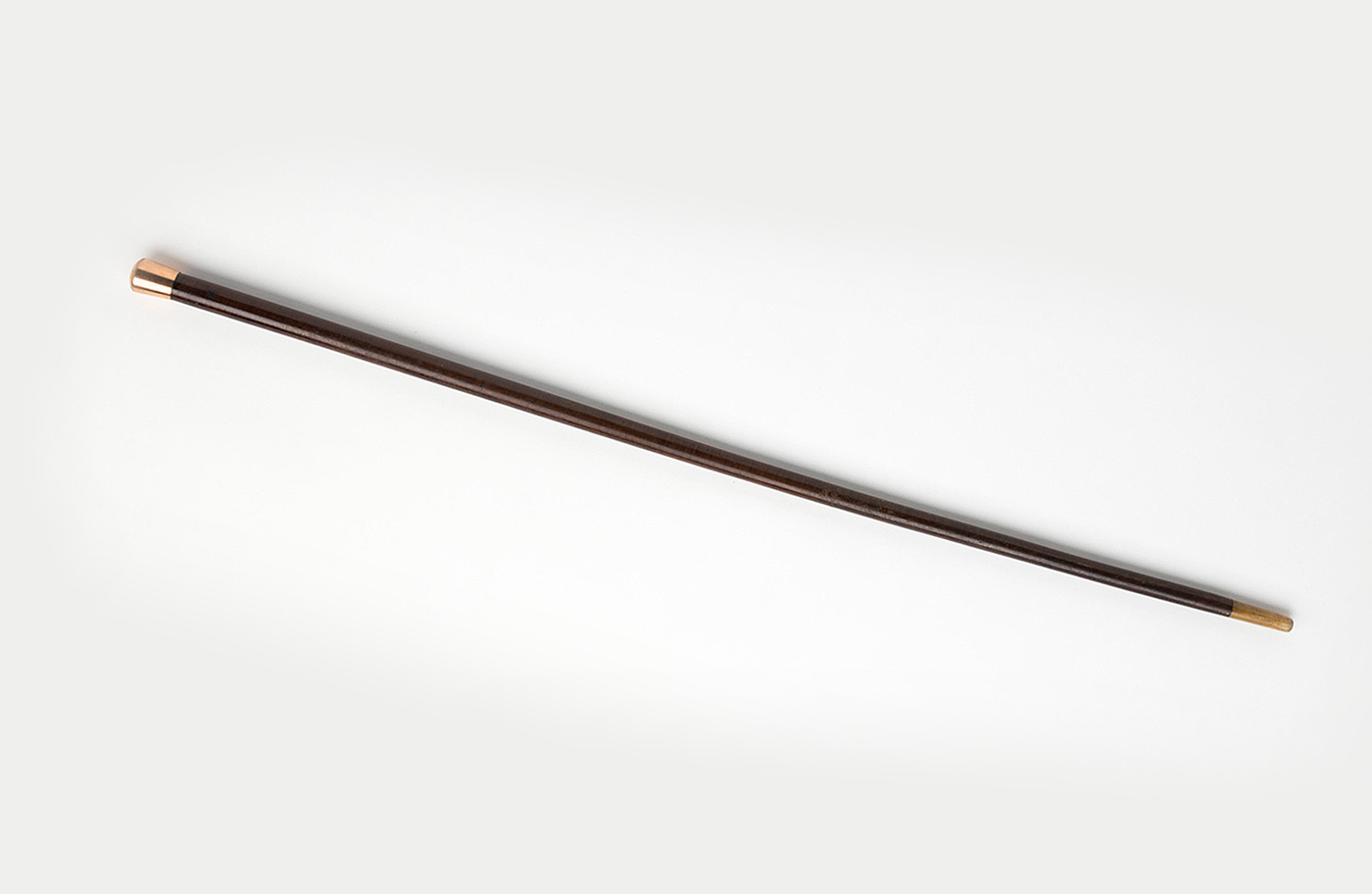
Adelaide Advertiser , 25 July 1913:
In reply [to Sir George Reid’s address], the King said:– 'It gives the Queen and myself much pleasure to be present on this interesting occasion, and to congratulate the Commonwealth organisation. The noble structure on this splendid site will take its place as a worthy and welcome addition to the buildings adorning the centre of the Empire, and call to the minds of passers-by the immense opportunities and limitless resources of the great continent under the Southern Cross.'
Gift from the King
Read the full text in Trove
King George V presented this walking stick to Sir George Reid on the laying of the foundation stone of Australia’s high commission in London. The gift was not purely ceremonial. Often caricatured over his rotund stature, Reid relied on a walking stick, and this one bears signs of wear.
Lawyer, politician and statesman, Reid played a significant role in the federation of the Australian colonies. In 1910, he was appointed Australia’s first high commissioner in London, a position he held until 1916, when he won a seat in the British House of Commons and became the only Australian to sit in the colonial, Commonwealth and Imperial parliaments.
As high commissioner, Reid was responsible for the construction of Australia’s first high commission. A dream of the newly federated Australian nation, it was expected to both promote the Australian Government’s aspirations and to confirm Australia’s place within London, the Empire and the world. Reid chose the name ‘Australia House’ because, he explained, ‘the word “House” carries with it the idea of a “home” for Australia in London’.
Reid was eager to acquire a building ‘over which the flag of the Southern Cross and the Union Jack would fly proudly’. The ceremonial laying of the foundation stone of Australia House in July 1913 provided an opportunity for the simultaneous affirmation of these loyalties. Crowded with an estimated 1500 people, London’s Strand was bathed in what has been frequently termed ‘Australian’ sunshine.
Accompanied by a flourish of trumpets, the King declared the stone ‘well and truly laid’ and, at Reid’s instigation, the crowd responded with cheers and a smattering of cooees. If a breach in court etiquette, the ardent applause and shouts were reportedly none the less welcome. Reid cabled excitedly that ‘the proceedings passed off without a single drawback, and were marked by a degree of enthusiasm on the part of the spectators, which, it was quite evident, delighted both Their Majesties’.
Preparations for the construction of the building were soon underway, and the attempt to shape diverse aspirations into material form commenced. In August 1918, long before Parliament House opened in Canberra, Australia House stood proudly in the Strand.
Reid lived just long enough to see it. The walking stick remained with his family until his granddaughter Anne Fairbairn donated it to the National Museum of Australia in 1992.
Behind the scenes – Australian Journeys series 13 Aug 2008
George reid: a journey through three parliaments.
- behind the scenes
- Download George Reid: a journey through three parliaments audio file (22.8 MB)
- View transcript
Explore more nation building
Explore more Glorious Days
You may also like
The National Museum of Australia acknowledges First Australians and recognises their continuous connection to Country, community and culture.
This website contains names, images and voices of deceased Aboriginal and Torres Strait Islander people.
Program: Correspondents Report
A visit to Australia House in London
- X (formerly Twitter)
A hundred years since the end of WWI, Australia House in London has also marked its centenary. It's Australia's oldest diplomatic mission.
- Samantha Hawley, Reporter
Correspondents Report
In this episode
US enforces a 'go slow' in asylum applications
Global eyes on encryption laws
'Holy well' lies beneath Australia House in London
Discover more podcasts
Download the ABC listen app to hear more of your favourite podcasts
Published daily by the Lowy Institute
Seeing Britain as a foreign country: The story of Australia House, London
In conjunction with the launch of the Lowy Institute's Global Diplomacy Index , we present a series of pieces on the role and continued relevance of embassies.
In his first post in this series, Ric Smith emphasised the crucial role Ambassadors and diplomats play in adding that extra layer of analytical rigour and depth to Canberra's grasp of what is happening overseas (' Embassies can shape policy ').
That issue of diplomatic reporting was one just of the factors at play in an obscure yet intriguing episode in the history of Australian diplomatic representation abroad: the transfer of responsibility for the administration of Australia House in London from the Department of the Prime Minister and Cabinet, which had controlled the post since its opening in 1910, to the Department of Foreign Affairs. Lest readers think this is some kind of wistful waltz down memory lane, a dusty missive from the archival coal face, the move was freighted with a great deal of significance and meaning for Australia's place in the world in that era.

On the face of it, as Stuart Ward and I showed in The Unknown Nation: Australia After Empire , the move represented little more than an administrative convenience, with few if any direct complications. But it also formed part of a far deeper conceptual change in the way Australia's relations with the UK were conceived and conducted.
The story begins in the late 1960s and 70s, in the wake of two seismic shocks to the national strategic imagination: Britain's impending entry into the EEC and its decision to draw down its military presence in Southeast Asia.
Accordingly, Australian politicians and policymakers began the process of putting the relationship with Britain on a 'foreign' footing. As Prime Minister John Gorton had bluntly told the then High Commissioner to the UK, Sir Alexander Downer, on his arrival in London in January 1969 for a Commonwealth Prime Ministers conference, Britain 'had become for Australians a foreign country'. The 'old links were breaking', Gorton told Downer in the car en route from Heathrow to the Savoy Hotel, and 'sentiment alone could not sustain our association'.
For Downer, himself known around the traps of Whitehall as 'violently Anglophile', the Prime Minister's assessment amounted to a kind of heresy. Later, he recounted how, at hearing Gorton's words, he had simply slumped back into his seat, finding solace in a world outside he saw as his own: 'though the light was grey, the trees bare, Kensington Road and Hyde Park did not look like a foreign country to me'. [fold]
Clearly, to acknowledge that Britain was simply one of a number of 'foreign' countries with which Australia did business was akin to relinquishing cherished ideas about Australia's place in the world as a 'British' country. But in the late 1960s, that kind of language, and that kind of worldview, was already becoming a serious liability: out of step with a changing Australia.
Although the Prime Minister's department vigorously resisted any suggestion that it cede control of Australia House — they saw the Australia-UK relationship as the special preserve of the PM and his British counterpart — nevertheless Foreign Affairs officials continued to make the case to their political masters that the transfer of responsibility should take place.
In 1971, for example, Foreign Affairs Secretary Keith Waller believed that the case for a transfer was simple: he observed that 'a factor in the past was that Australians thought of themselves primarily as "British". Most now think of themselves as "Australians"'. The need, therefore, to 'mark our relations with Britain as something special...no longer exists'.
As Stuart Ward has pointed out, no other country in the Commonwealth had a separate department of state to deal with Britain, and 'with the merger of the Commonwealth and Foreign Offices in Britain in 1968, it seemed natural and normal that Australia should adjust its own administrative practices accordingly'.
Waller's insistence on making the change also unleashed some internal departmental frustrations about the kind of reporting on British politics that it had been receiving from High Commissioner Downer at that time. Nigel Bowen told Prime Minister McMahon that as Foreign Minister he had 'less information as to what is the thinking of the UK government on various issues than from the other capitals in which we have the higher representation from Foreign Affairs'. In the Prime Minister's Department, those comments were taken as a 'vote of total no confidence in the present High Commissioner'.
Downer's trenchant views on many of the key issues facing the two countries at this time — not least Britain's EEC ambitions — were being interpreted as out of step with opinion back home in Australia, and his judgment was being called into question. Even the British Defence Secretary, Denis Healey, confided to Australia's High Commissioner in Singapore that 'poor old Alex...doesn't really understand us and we find there is not much point in talking to him...how much longer does he have to serve?'.
Downer was vehemently against the idea of a transfer of responsibility for running Australia House, but had been effectively shut out of the negotiations. He was, however, supported initially by McMahon, who reminded Bowen that for many Australians, 'Britain has a special place not occupied by any other country in the world'.
A bitter debate then ensued between the Prime Minister's Department and the Department of Foreign Affairs. In the resulting compromise, McMahon retained responsibility for ties to the Crown, Commonwealth Prime Ministers conferences and the right to appoint the High Commissioner. Foreign Affairs acquired the right to appoint their own career officers to the crucial deputy high commissioner post, thereby securing effective responsibility for the mission.
When Prime Minister McMahon announced the decision in 1972, however, he said that it took place 'against the background of Britain's entry into Europe'. Far from representing a simply bureaucratic switch, the decision indicated that in the wider atmosphere of Australia's shifting policies and priorities following the demise of the British race idea, the old hearth at the heart of empire was to be treated just like any other Australian mission abroad.
You may also be interested in
70 years of the geneva conventions and why we need them more than ever, the disproportionate attention on the solomons-china security pact, who cares about the australia-china relationship.

Australia House London | Book Reveals The Untold Story
by Progressive Traveller | Europe , Featured , Oceania , United Kingdom (UK)
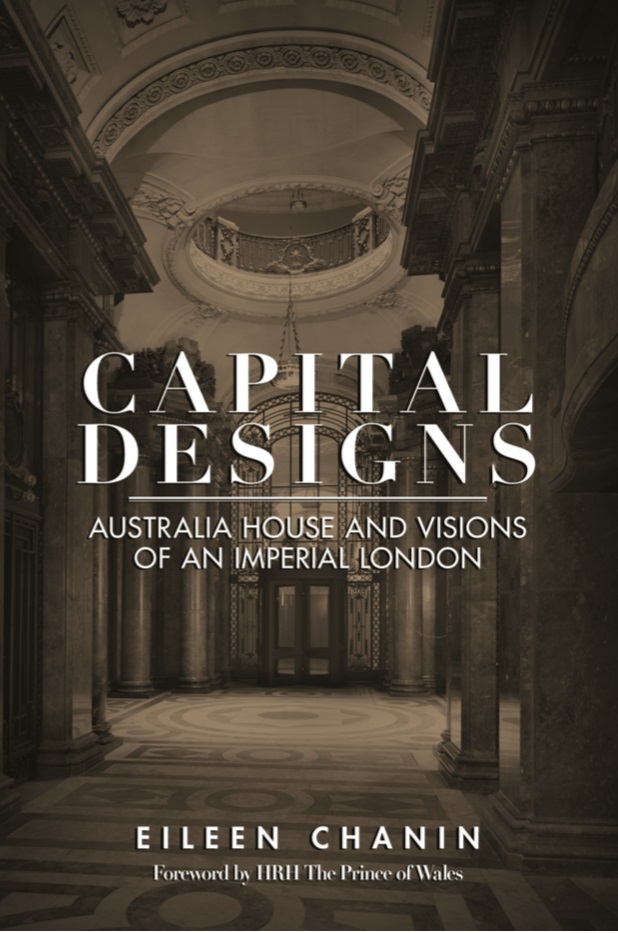
Dr Eileen Chanin | Australian Author
Australian award-winning author and research associate of Australian Studies Institute, Eileen Chanin has released her new book Capital Designs: Australia House and Visions of an Imperial London (2018). Dr Chanin holds a PHD from University New South Wales Australia and is a Sydney-based historian. Her latest book Capital Designs: Australia House and Visions of an Imperial London is the untold story of how Australia’s first diplomatic mission was conceived, designed and built.
Australia House Celebrates its 100th Birthday in 2018
London Landmark Building
The Australian Government purchased the vacant triangular-shaped block in 1912 which was formerly the site of Victoria House. Victoria House was built in 1907 on the corner of Aldwych and the Strand and west of Melbourne Place. The land was abandoned and unkept for many years before the Australian Government acquired the freehold in the heart of London. The land cost the Australian people £379, 756 and the overall cost of the building and other associated expenses tallied to approximately £1 million. Although, an Official Secretary had been appointed to London as early as 1906, the Australian High Commission to London was the first Australian diplomatic mission and one of the most prominent in London.
War Time Construction
Building Australia House commenced during World War 1 however completion was delayed due to the rigors of the Great War. Home grown timbers and stone were shipped from Australia to London. The first foundation stone was laid by King George V on 24 July 1913. Queen Mary and Princess Mary accompanied the King. A large crowd of mostly enthusiastic Australians gathered for the event and shouted the Australian bush call ‘Coo-ee’ at the end of the ceremony. His majesty officially opened the purpose-built dominion embassy ‘Australia House’ on 3 August 1918. Australian Prime Minister William Morris Hughes and former Prime Minister Andrew Fisher were among the official party. The famous building celebrated its 100th birthday in 2018.
Design | Build | Preserve
Scottish architects designed the Australia House building after winning an architectural competition. Alexander Marshal Mackenzie and Son were awarded the project by leading Australian artists – Arthur Streeton, John Longstaff, Fred Leist, George Lambert and Bertram Mackennal. Mackennal, an Australian sculptor and medallist, famous for designing the coinage and stamps bearing the likeness of George V, was also a judge for the architectural competition.
John Smith Murdoch, a chief architect of the Commonwealth of Australia worked together with the Mackenzie company throughout the construction of the building. Islington builders, Dove Brothers began construction in 1913 however much of the construction was delayed due to shipping problems related to the Great War.
London Spring Water | Good Enough to Drink
A rectangular-shaped well in the basement of the Australia diplomatic mission is thought to be over 900 years old. The spring runs under Australia House and is still accessible. The centuries old spring is just one of 20, covered by buildings and roads throughout London. It is one of the few natural springs still reachable in the UK. Scientists have confirmed the water is safe to drink and better than tap water. The spring comes from the River Fleet, a subterranean London River.
Australian High Commission | Harry Potter Filming Locations
Where was Harry Potter filmed in London? The movie Harry Potter and the Philosopher’s Stone were partially filmed inside Australia House. The interior of Australia House in London was the set for Gringotts Wizarding Bank and Gringotts Grand Entrance Hall. In more recent times, the Australian Consulate was used as a backdrop for the 2017 Wonder Woman superhero movie. Australia House is not open to the public, but it can be viewed for Free from outside. The nearest tube station is Temple, which is a 5-minute walk.
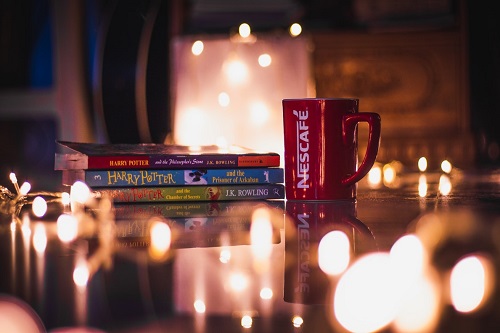
Travel Insurance
Get Your Guide
About the progressive traveller.

Receive Travel Updates
Subscribe to receive the best travel stuff directly in your inbox. Your email address will never ever be shared, and you can easily unsubscribe whenever you want.
Privacy consent I agree to Progressive Traveller's Privacy Policy.
Welcome to the Progressive Traveller Tribe, we are so happy you are here. The Progressive Traveller was founded because we wanted to create an inspiring place for you to find everything you need to know about travel. We sent you an email to confirm your wish to join our community, so keep an eye out for an email from the Progressive Traveller. Happy Days, Donna
Travel planning resources, book your experience.
GetYourGuide: Diverse experiences, easy booking, better travel.
Accommodation Choices Galore
Discover limitless accommodation options with Booking.com
DiscoverCars.com: Your Perfect Car, Anywhere, Every Time.
Protect You and Your Belongings
World Nomads: Full protection, worry-free adventures.
Packing Checklist
Join the Progressive Traveller Community and get my proven Packing Checklist from the eBook. Subscribe now.
Embark on Adventures with Us: Join Our Vibrant Travel Community!
Join our community to receive exciting travel news, inspiring stories, and exclusive special offers. Stay in the loop about trending destinations, insider tips, and unforgettable journeys. Let's embark on this adventure together!
Your email address will never ever be shared, and you can easily unsubscribe whenever you want.
Privacy Overview

Join Our Vibrant Travel Community!
Join our community to receive exciting travel news, inspiring stories, and exclusive special offers. Stay in the loop about trending destinations, insider tips, and unforgettable journeys. Let's embark on this adventure together!
Your email address will never ever be shared, and you can easily unsubscribe whenever you want. See our Privacy Policy
Welcome to the Progressive Traveller Tribe. You have successfull subscribed.
- Science & Environment
- History & Culture
- Opinion & Analysis
- Destinations
- Activity Central
- Creature Features
- Earth Heroes
- Survival Guides
- Travel with AG
- Travel Articles
- About the Australian Geographic Society
- AG Society News
- Sponsorship
- Fundraising
- Australian Geographic Society Expeditions
- Sponsorship news
- Our Country Immersive Experience
- AG Nature Photographer of the Year
- Web Stories
- Adventure Instagram
Bicycle repository. Bank vaults in the basement of Australia House held gold bullion in the first half of the 20th century, but are now home to bicycles and archived files.
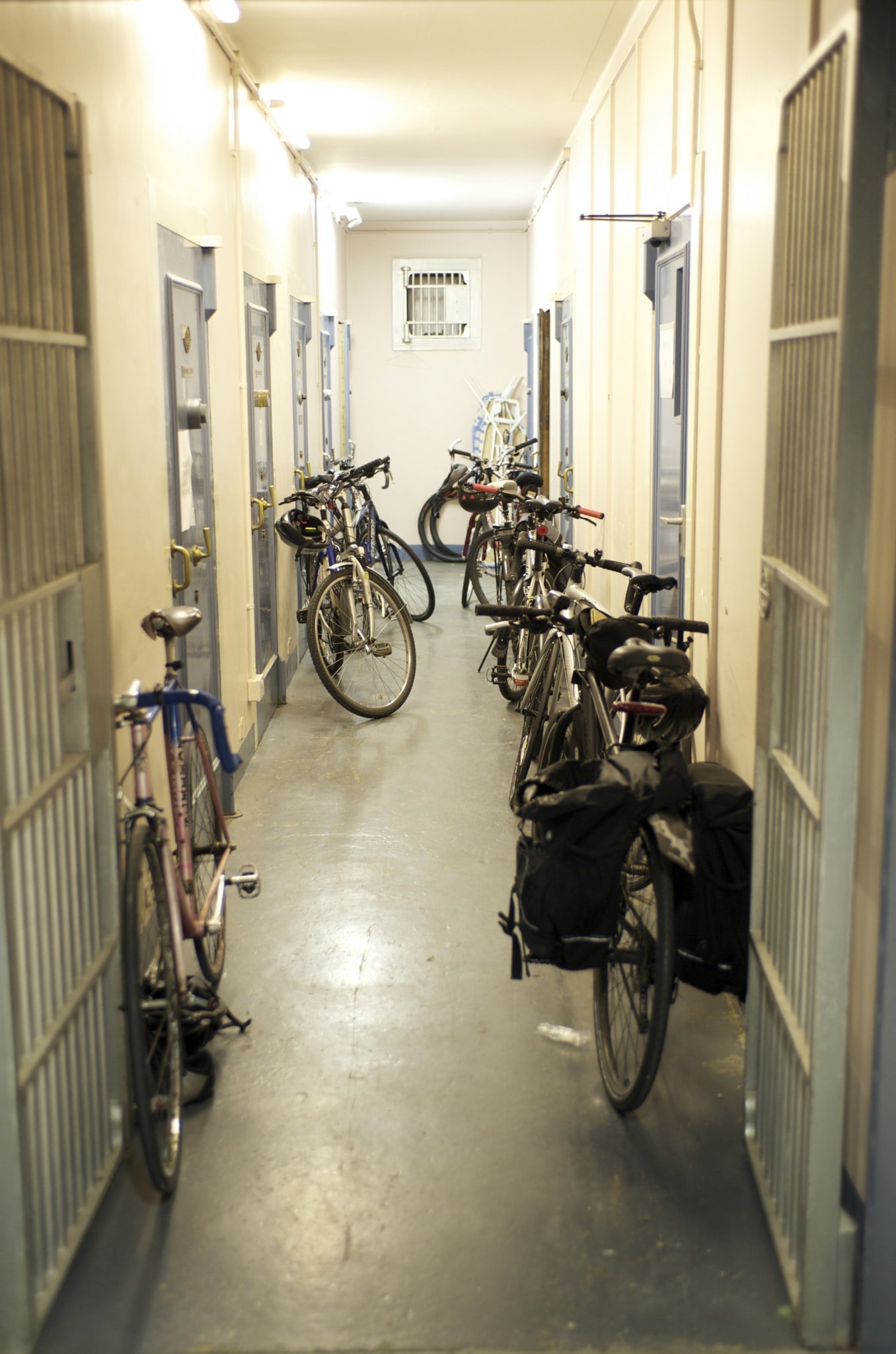
Opulent outpost. An imposing feature of Australia House.
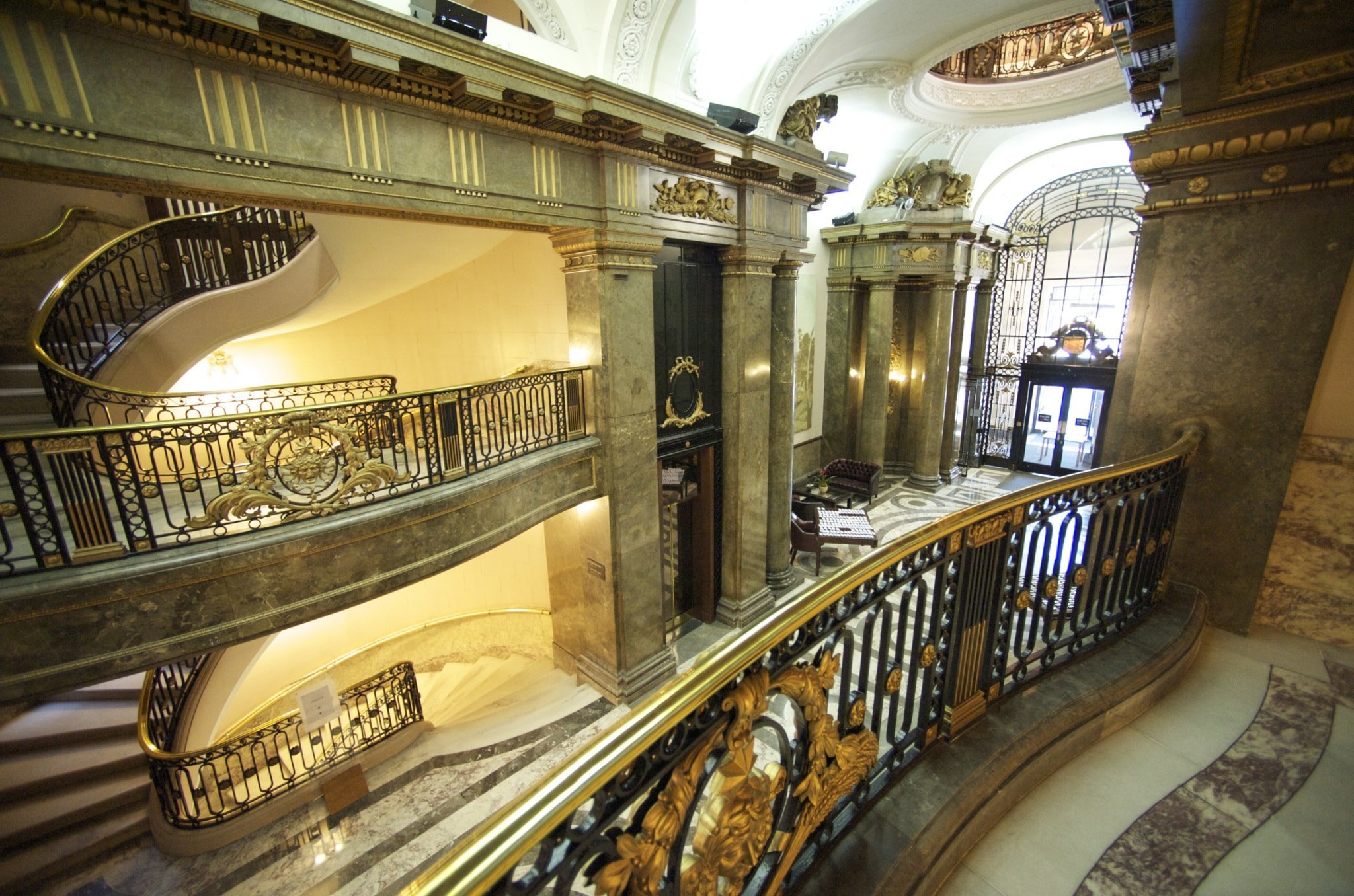
The Australian High Commission, The `Strand London WC2b 4LA.
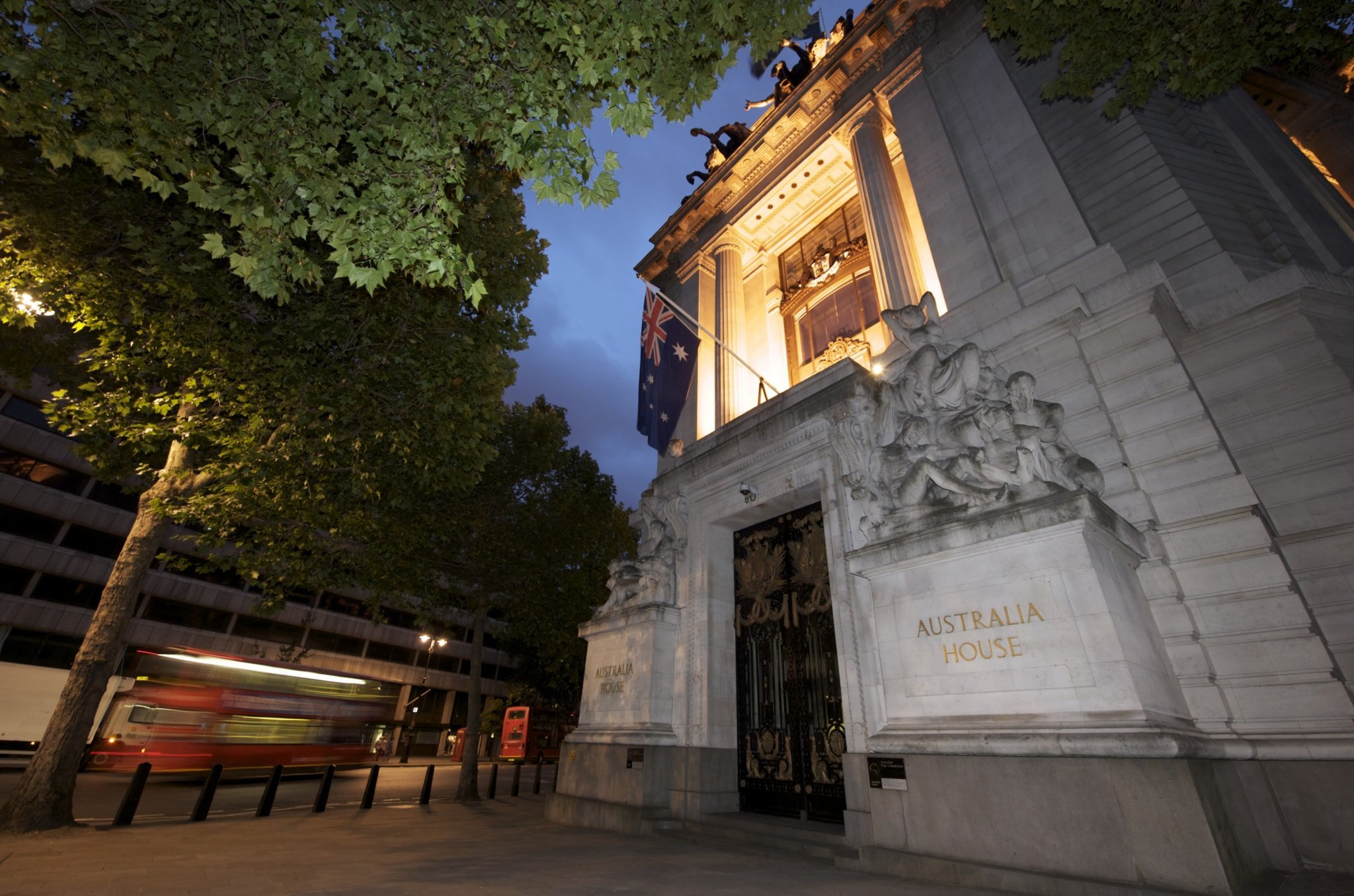
Hobnobbing. Sally Capp (above), former agent-general for Victoria, prepares to play host to guests in her offices in the adjoining building, Victoria House. The agents-general were once the official diplomatic representatives of the Australian colonies in the capital of the empire, but today they focus on promoting tourism and business interests.
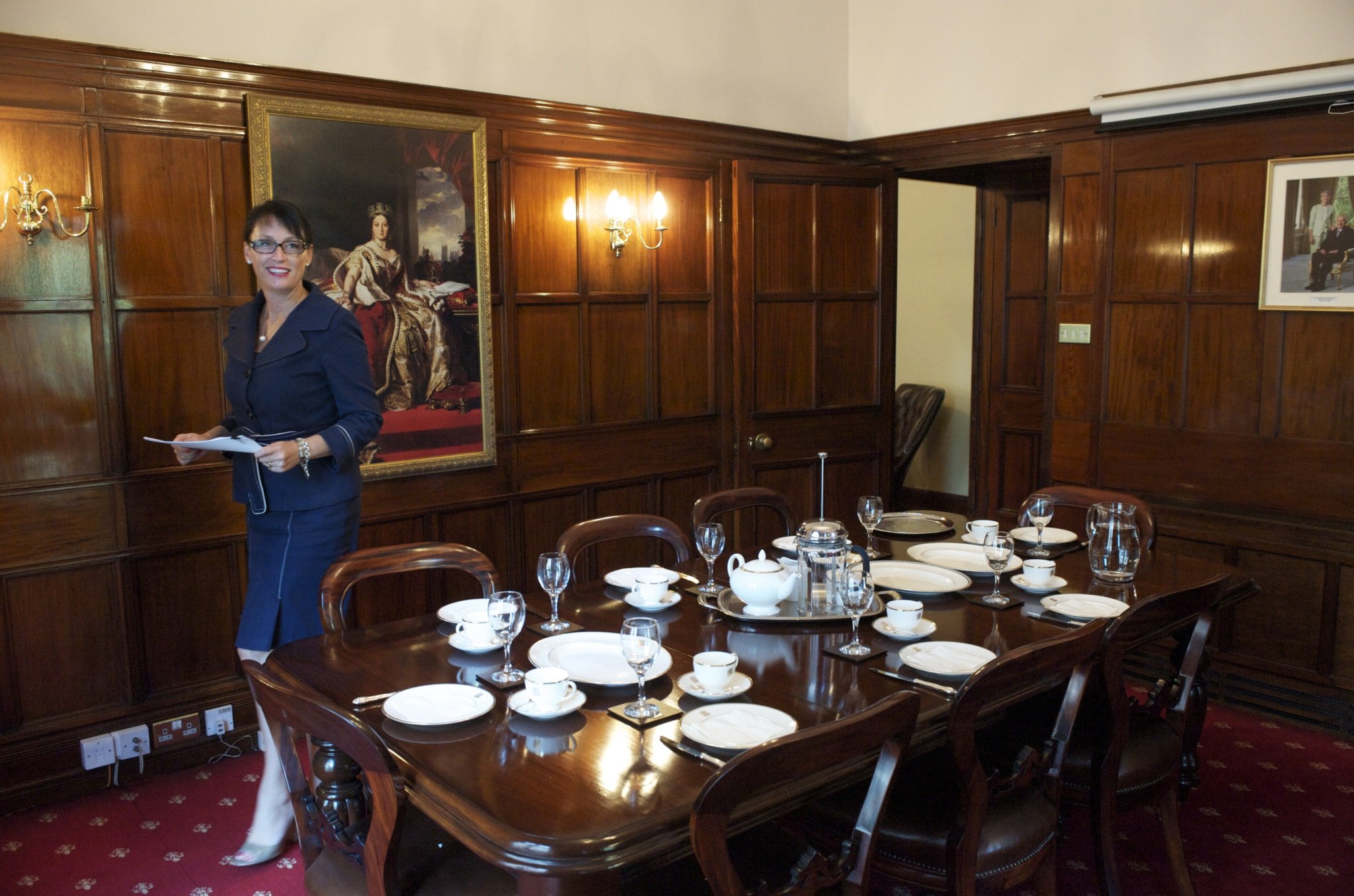
Night music. The Australian String Quartet practices for a concert hosted by the agent-general of South Australia; cultural outreach is another task performed by diplomatic missions overseas. The Exhibition Hall features nine chandeliers of Empire design, made in Milan using hand-cut Bohemian crystal.
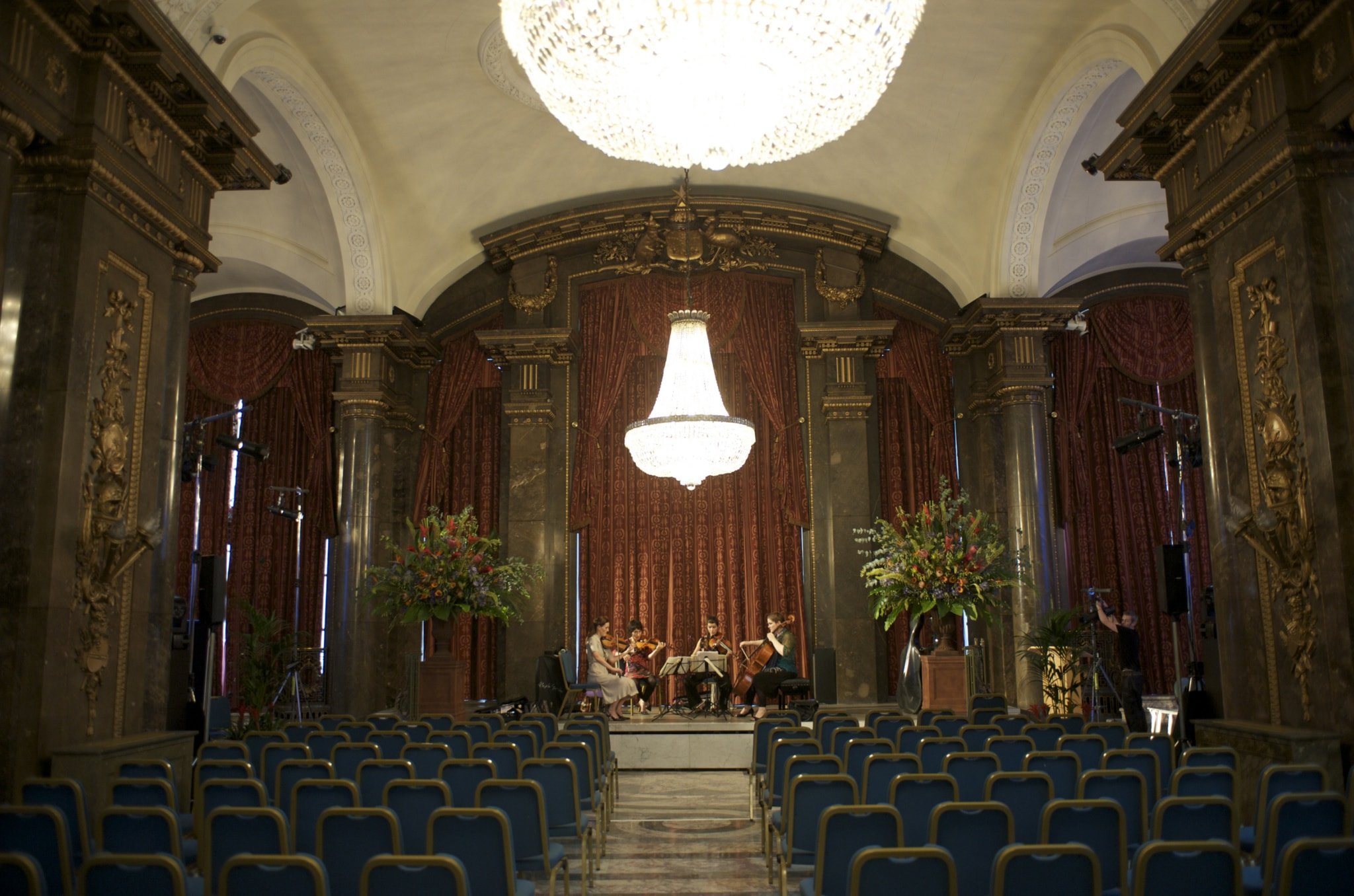
Home Topics History & Culture 100 years of Australia House
100 years of Australia House

Completed in 1918, Australia House is a lavish building, which is steeped in history, and the home of our oldest diplomatic mission. Described in 1930 by one journalist as the “national foyer”, it’s been much more than an embassy for many of its 100 years, once housing banking facilities, a poste restante, an information counter, a cafeteria and a reading room. With heightened security concerns, much of that has gone, but a small piece of Australia still exists on a triangle of land between Aldwych and the Strand in London’s West End. In the centre of Australia House is the high commissioner’s office.

Ever heard of a moonbird?
The strong connection between King Island’s people and its moonbirds is celebrated by an arts festival bringing culture and conservation together.

Why (most) Aussies love daylight saving
Daylight saving has 80 per cent support in Australia and a majority in every state.

Who invented the flat white?
Australia’s coffee culture – a source of great national pride – is usually associated with the wave of Greek and Italian migrants who settled in Melbourne and Sydney following the second world war. But it was very likely in regional Queensland that one of Australia’s favourite brews first took root.
Watch Latest Web Stories
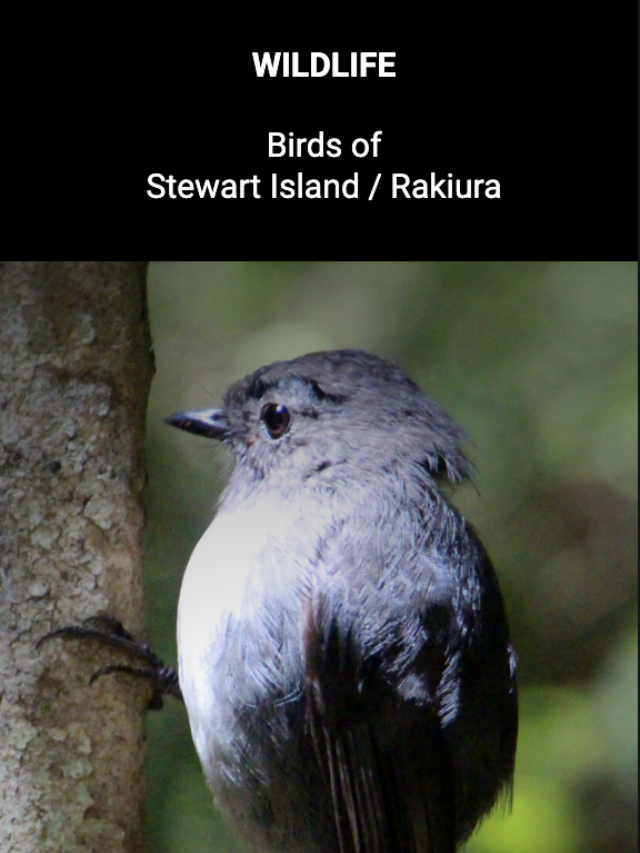
Birds of Stewart Island / Rakiura
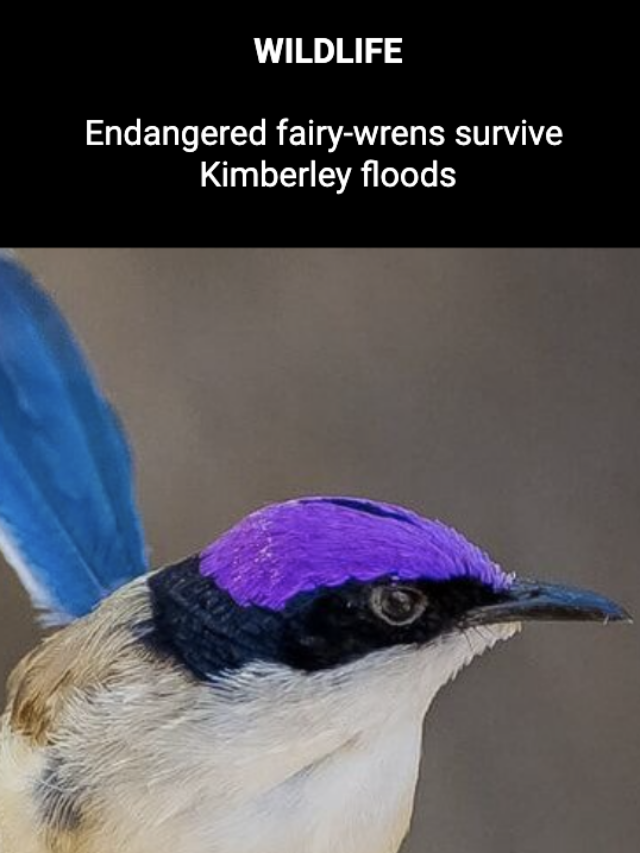

Endangered fairy-wrens survive Kimberley floods
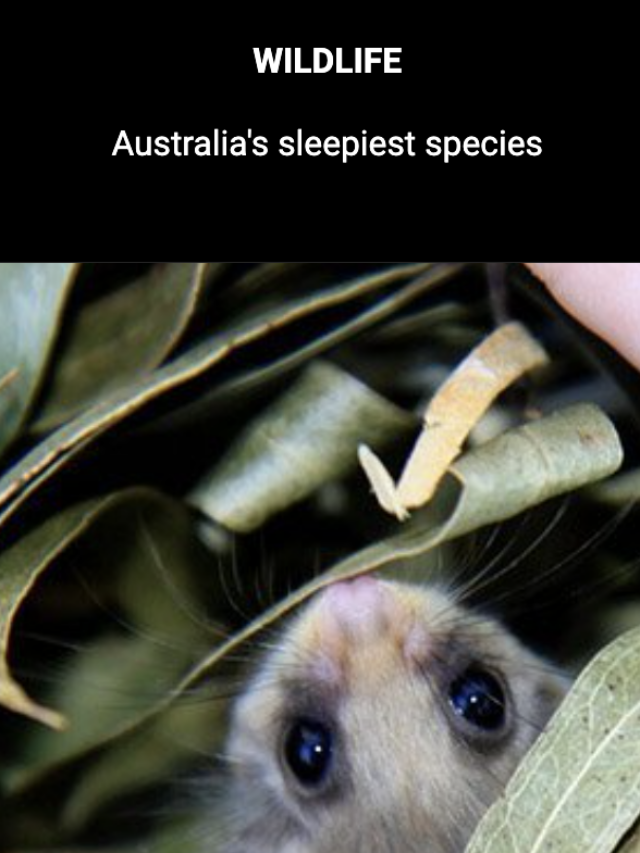
Australia’s sleepiest species

2024 Calendars & Diaries - OUT NOW
Our much loved calendars and diaries are now available for 2024. Adorn your walls with beautiful artworks year round. Order today.

In stock now: Hansa Soft Toys and Puppets
From cuddly companions to realistic native Australian wildlife, the range also includes puppets that move and feel like real animals.

Countries, economies and regions
Select a country, economy or region to find embassies, country briefs, economic fact sheets, trade agreements, aid programs, information on sanctions and more.
International relations
Global security.
- Australia and sanctions
- Australian Safeguards and Non-proliferation Office (ASNO)
- Counter-terrorism
- Non-proliferation, disarmament and arms control
- Peacekeeping and peacebuilding
Regional architecture
- Asia Pacific Economic Cooperation (APEC)
- Association of Southeast Asian Nations (ASEAN)
- East Asia Summit (EAS)
- Australia and the Indian Ocean region
- Pacific Islands regional organisations
Global themes
- Child protection
- Climate change
- Cyber affairs and critical technology
- Disability Equity and Rights
- Gender equality
- Human rights
- Indigenous peoples
- People Smuggling, Human Trafficking and Modern Slavery
- Preventing Sexual Exploitation, Abuse and Harassment
- Australia’s treaty-making process
International organisations
- The Commonwealth of Nations
- United Nations (UN)
- World Trade Organization
Foreign Arrangements Scheme
Trade and investment, about free trade agreements (ftas).
- The benefits of FTAs
- How to get free trade agreement tariff cuts
- Look up FTA tariffs and services market access - DFAT FTA Portal
- Discussion paper on potential modernisation – DFAT FTA Portal
About foreign investment
- The benefits of foreign investment
- Investor-state dispute settlement (ISDS)
- Australia's bilateral investment treaties
- Australia's foreign investment policy
For Australian business
- Addressing non-tariff trade barriers
Expo 2025 Osaka, Kansai
Stakeholder engagement.
- Ministerial Council on Trade and Investment
- Trade 2040 Taskforce
- First Nations trade
Australia's free trade agreements (FTAs)
- ASEAN-Australia-New Zealand (AANZFTA)
- Chile (ACLFTA)
- China (ChAFTA)
- Hong Kong ( A-HKFTA & IA)
- India (AI-ECTA)
- Indonesia (IA-CEPA)
- Japan (JAEPA)
- Korea (KAFTA)
- Malaysia (MAFTA)
- New Zealand (ANZCERTA)
- Peru (PAFTA)
- Singapore (SAFTA)
- Thailand (TAFTA)
- United Kingdom (A-UKFTA)
- USA (AUSFTA)
- Trans-Pacific Partnership (TPP)
- European Union (A-EUFTA)
- India (AI-CECA)
- Australia-UAE Comprehensive Economic Partnership Agreement
- Australia-Gulf Cooperation Council (GCC)
Trade and investment data, information and publications
- Fact sheets for countries and regions
- Australia's trade balance
- Trade statistics
- Foreign investment statistics
- Trade and investment publications
- Australia's Trade through Time
WTO, G20, OECD, APEC and IPEF and ITAG
Services and digital trade.
- Service trade policy
- Australia-Singapore Digital Economy Agreement
- Digital trade & the digital economy
Development
Australia’s development program, performance assessment.
- Development evaluation
- Budget and statistical information
Who we work with
- Multilateral organisations
- Non-government organisations (NGOs)
- List of Australian accredited non-government organisations (NGOs)
Development topics
- Development issues
- Development sectors
2030 Agenda for Sustainable Development
- Sustainable Development Goals
Where we deliver our Development Program
Humanitarian action.
Where and how Australia provides emergency assistance.
People-to-people
Australia awards.
- Australia Awards Scholarships
- Australia Awards Fellowships
New Colombo Plan
- Scholarship program
- Mobility program
Public diplomacy
- Australian Cultural Diplomacy Grants Program
- Australia now
- UK/Australia Season 2021-22
Foundations, councils and institutes
- Australia-ASEAN Council
- Australia-India Council
- Australia-Indonesia Institute
- Australia-Japan Foundation
- Australia-Korea Foundation
- Council for Australian-Arab Relations (CAAR)
- Council on Australia Latin America Relations (COALAR)
International Labour Mobility
- Pacific Labour Mobility Scheme
- Agriculture Visa
Australian Volunteers Program
Supporting organisations in developing countries by matching them with skilled Australians.
Sports diplomacy
Australia is a successful global leader and innovator in sport.
A global platform for achievement, innovation, collaboration, and cooperation
About Australia
Australia is a stable, democratic and culturally diverse nation with a highly skilled workforce and one of the strongest performing economies in the world.
Australia in Brief publication
This is the 52nd edition of Australia in Brief, revised and updated in February 2021
Travel advice
To help Australians avoid difficulties overseas, we maintain travel advisories for more than 170 destinations.
- Smartraveller – travel advice
International COVID-19 Vaccination Certificate
Prove your COVID-19 vaccinations when you travel overseas.
- Services Australia
The Australian Passport Office and its agents are committed to providing a secure, efficient and responsive passport service for Australia.
- Australian Passport Office
24-hour consular emergency helpline
- Within Australia: 1300 555 135
- Outside Australia: +61 2 6261 3305
- Getting help overseas
- Visas for Australians travelling overseas
- Visas to visit Australia
Our embassies and consulates overseas
Australian high commission, united kingdom, head of mission.
Australian High Commissioner to United Kingdom
Australia House The Strand London WC 2B 4LA United Kingdom
+44 20 7379 4334
+44 20 7887 5558
Australian High Commission in United Kingdom website
Australia House, London
On Tuesday 26th March the AIIA NSW hosted the Sydney launch of Dr Eileen Chanin’s new book Capital Designs, Australia House and Visions of an Imperial London . In conversation with Neal Blewett AC, Dr Chanin discussed how the construction of Australia’s oldest diplomatic mission, Australia House, transformed central London.
The grand, classical-style Australia House was one of the first buildings to be erected on the then vacant parcel of land between Aldwych and the Strand, the critical connecting road between the Parliament at Westminster and the City of London. The choice of location signified a newly federated Australia’s ambition to carve a dignified place for itself in the trading and financial capital of the world to attract both investment and immigrants. The project was enthusiastically supported by the British monarchy and the elite, who saw in the redevelopment the opportunity to visually project Britain’s status as a culturally sophisticated global power and leader of the Commonwealth.
Notably, Australia House was the first purpose-built diplomatic building in London. Work began in 1913, and Australia House was officially opened on 3 August 1918. The completed building features wood and marble shipped from Australia and sculptures carved by an Australian artist, Harold Parker. Today, it is renowned as one of the finest remaining examples of early 20th century architecture in London, which has made it popular with film productions including Wonder Woman and the Harry Potter franchise.
The history of the construction of Australia House encapsulates many of the changes that were occurring at the turn of the century. New developments in mechanisation, construction techniques and town planning are married with the financial demands of federalism and the growth of Australian national identity. As the traumatic First World War, confronting the rising power of Germany, drew to its close, Australia House – still not quite complete – was the site of a triumphal march of returning British and Empire troops.
Dr Chanin’s thoroughly researched book and its striking collection of photographs celebrate the achievements of the many individuals who collaborated to turn Australia’s vision into a reality, from Prime Ministers and State Premiers to architects to King George V. With the construction of Australia House, Australia proudly announced its presence on the global stage.
Report by Lucy Nason, AIIA NSW intern
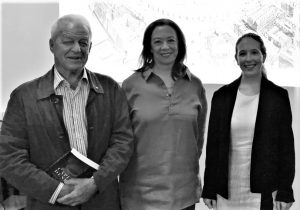
Neal Blewett AC, Eileen Chanin and Lucy Nason
Choose your preferred currency

Australian and New Zealand visas: Expert advice and assistance
Australian Embassy
Australia house london - australian embassy ireland.
Australian Embassy, Embassies and Consulates are government offices that can be found in most capital cities around the world. The Australia Embassy in London is open to the public for the purpose of attaining visas to visit Australia.
The Australian Embassy in Dublin is only available for consular/passport services.
If you wish to apply for a visa to enter Australia you may apply online or in person at the Australian High Commission.
We are able to assist you if you wish to apply for an Australian tourist, business or working holiday visa via the online application facility.
We process visas using the central government issuing offices in Australia, with your authorisation we can liaise directly with government offices regarding any communication required to issue your travel visas.
We have provided a comprehensive list below should you need to visit or contact your nearest Embassy.
United Kingdom: Australian High Commission, Australia House, The Strand, London WC2B 4LA Phone: (020) 7379 4334 www.australia.org.uk
Ireland: Australian Embassy, Fitzwilton House, Wilton Terrace, Dublin Phone: (01) 6761517 http://ireland.embassy.gov.au
- Angola (Australian Consulate - Luanda)
- Austria (Australian Embassy and Permanent Mission to the United Nations - Vienna)
- Bangladesh (Australian High Commission - Dhaka)
- Belgium (Australian Embassy - Brussels)
- Bolivia (Australian Consulate - La Paz)
- Brazil (Australian Consulate-General - Sao Paulo)
- Brazil (Australian Consulate - Rio de Janeiro)
- Brazil (Australian Embassy - Brasilia)
- Brunei Darussalam (Australian High Commission - Bandar Seri Begawan)
- Bulgaria (Australian Consulate - Sofia)
- *** Burkina Faso (Canadian Embassy - Ouagadougou)
- Burma (Australian Embassy - Rangoon)
- Cambodia (Australian Embassy - Phnom Penh)
- *** Cameroon (Canadian High Commission - Yaounde)
- Canada (Australian Consulate-General - Toronto)
- Canada (Australian High Commission - Ottawa)
- Canada (Australian Consulate - Vancouver)
- Chile (Australian Embassy - Santiago de Chile)
- China (People's Republic of) (Australian Consulate-General - Hong Kong)
- China (People's Republic of) (Australian Consulate-General - Shanghai)
- China (People's Republic of) (Australian Embassy - Beijing)
- China (People's Republic of) (Australian Consulate-General - Guangzhou)
- Colombia (Australian Consulate - Bogota)
- *** Costa Rica (Canadian Embassy - San Jose)
- *** Cote d'Ivoire (Canadian Embassy - Abidjan)
- Croatia (Australian Embassy - Zagreb)
- *** Cuba (Canadian Embassy - Havana)
- Cyprus (Australian High Commission - Nicosia)
- Czech Republic (Australian Consulate - Prague)
- *** Democratic Republic of Congo (Zaire) (Canadian Embassy - Kinshasa)
- Denmark (Australian Embassy - Copenhagen)
- East Timor (Australian Mission - Dili)
- Ecuador (Australian Consulate - Guayaquil)
- Egypt (Australian Embassy - Cairo)
- Estonia (Australian Consulate - Tallinn)
- *** Ethiopia (Canadian Embassy - Addis Ababa)
- Federated States of Micronesia (Australian Embassy - Pohnpei)
- Fiji (Australian High Commission - Suva)
- Finland (Australian Consulate - Helsinki)
- France (Australian Delegation to OECD - Paris)
- France (Australian Embassy - Paris)
- *** Gabon (Canadian Embassy - Libreville)
- Ghana (Australian High Commission - Accra)
- Germany (Australian Consulate-General - Frankfurt)
- Germany (Australian Embassy - Berlin)
- Greece (Australian Consulate - Thessaloniki)
- Greece (Australian Embassy - Athens)
- *** Guatemala (Canadian Embassy - Guatemala City)
- *** Guinea (Canadian Embassy - Conakry)
- Hungary (Australian Embassy - Budapest)
- India (Australian High Commission - New Delhi)
- India (Australian Consulate-General - Mumbai)
- Indonesia (Australian Consulate - Medan)
- Indonesia (Australian Embassy - Jakarta)
- Indonesia (Australian Consulate-General - Bali)
- Iran (Australian Embassy - Tehran)
- Iraq (Australian Embassy - Baghdad)
- Ireland (Australian Embassy - Dublin)
- Israel (Australian Embassy - Tel Aviv)
- Italy (Australian Embassy - Rome)
- Italy (Australian Consulate-General - Milan)
- Japan (Australian Embassy - Tokyo)
- Japan (Australian Consulate - Sapporo)
- Japan (Australian Consulate - Sendai)
- Japan (Australian Consulate - Nagoya)
- Japan (Australian Consulate General - Osaka)
- Japan (Australian Consulate-General - Fukuoka City)
- Jordan (Australian Embassy - Amman)
- Kenya (Australian High Commission - Nairobi)
- Kiribati (Australian High Commission - Tarawa)
- Korea (Republic of) (Australian Embassy - Seoul)
- Korea (Republic of) (Honorary Consulate - Pusan)
- Kuwait (Australian Embassy - Kuwait City)
- Laos (Australian Embassy - Vientiane)
- Lebanon (Australian Embassy - Beirut)
- Lithuania (Australian Consulate - Vilnius)
- Macedonia, Former Yugoslav Republic of (Australian Consulate - Skopje)
- Malaysia (Australian Consulate - Penang)
- Malaysia (Australian Consulate - Kota Kinabalu, Sabah)
- Malaysia (Australian High Commission - Kuala Lumpur)
- Malaysia (Australian Consulate - Kuching, Sarawak)
- *** Mali (Canadian Embassy - Bamako)
- Malta (Australian High Commission - Malta)
- Mauritius (Australian High Commission - Port Louis)
- Mexico (Australian Consulate - Guadalajara)
- Mexico (Australian Embassy - Mexico City)
- Mexico (Australian Consulate - Monterrey, Nuevo Leon)
- *** Morocco (Canadian Embassy - Rabat-Agdal)
- Mozambique (Australian Consulate - Maputo)
- Nepal (Australian Embassy - Kathmandu)
- Netherlands (Australian Embassy - The Hague)
- New Caledonia (Australian Consulate-General - Noumea)
- New Zealand (Australian High Commission - Wellington)
- New Zealand (Australian Consulate-General - Auckland)
- *** Niger (Office of the Canadian Embassy - Niamey)
- Nigeria (Australian High Commission - Abuja)
- Palestinian Authority (Australian Representative Office - Ramallah)
- Pakistan (Australian High Commission - Islamabad)
- Pakistan (Australian Consulate - Karachi)
- Papua New Guinea (Australian High Commission - Port Moresby)
- Papua New Guinea (Australian Consulate - Lae)
- Peru (Australian Consulate-General - Lima)
- Philippines (Australian Embassy - Manila)
- Poland (Australian Embassy - Warsaw)
- Portugal (Australian Embassy - Lisbon)
- Qatar (Australian Embassy - UAE)
- Romania (Australian Consulate-General - Bucharest)
- Russia (Australian Consulate - Vladivostok)
- Russia (Australian Embassy - Moscow)
- Russia (Australian Consulate - St.Petersburg)
- Samoa (Australian High Commission - Apia)
- Saudi Arabia (Australian Embassy - Riyadh)
- *** Senegal (Canadian Embassy - Dakar)
- Serbia and Montenegro (Australian Embassy - Belgrade)
- Singapore (Australian High Commission - Singapore)
- Slovenia (Australian Consulate - Ljubljana)
- Solomon Islands (Australian High Commission - Honiara)
- South Africa (Australian High Commission - Pretoria)
- South Africa (Australian Consulate-General - Johannesburg)
- South Africa (Australian Consulate - Durban)
- Spain (Australian Consulate - Seville)
- Spain (Australian Embassy - Madrid)
- Spain (Australian Consulate - Barcelona)
- Sri Lanka (Australian High Commission - Colombo)
- Sweden (Australian Embassy - Stockholm)
- Switzerland (Australian Permanent Mission to the WTO - Geneva)
- Switzerland (Australian Consulate-General - Geneva)
- Switzerland (Australian Permanent Mission to the Office of the United Nations; Delegation to the Conference on Disarmament - Geneva)
- *** Syria (Canadian Embassy - Damascus)
- Taiwan (Australian Commerce and Industry Office - Taipei)
- *** Tanzania (Canadian High Commission - Dar es Salaam)
- Thailand (Australian Embassy - Bangkok)
- The Holy See (Australian Embassy - Rome)
- Tonga (Australian High Commission - Nuku'Alofa)
- Trinidad and Tobago (Australian High Commission - Port of Spain)
- *** Tunisia (Canadian Embassy - Tunis-Belvedere)
- Turkey (Australian Consulate-General - Istanbul)
- Turkey (Australian Embassy - Ankara)
- Ukraine (Australian Consulate - Kyiv)
- United Arab Emirates (Australian Consulate-General - Dubai)
- United Arab Emirates (Australian Embassy - Abu Dhabi)
- United Kingdom (Australian Consulate - Edinburgh)
- United Kingdom (Australian High Commission - London)
- United States of America (Australian Consulate-General - New York)
- United States of America (Australian Consulate - Detroit)
- United States of America (Australian Embassy - Washington DC)
- United States of America (Australian Mission to the United Nations - New York)
- United States of America (Australian Consulate - Miami)
- United States of America (Australian Consulate-General - San Francisco)
- United States of America (Australian Consulate-General - Chicago)
- United States of America (Australian Consulate-General - Honolulu)
- United States of America (Australian Consulate - Houston)
- United States of America (Australian Consulate-General - Los Angeles)
- United States of America (Australian Consulate - Denver)
- United States of America (Australian Consulate-General - Atlanta)
- Uruguay (Australian Consulate - Montevideo)
- Vanuatu (Australian High Commission - Port Vila)
- Vietnam (Australian Embassy - Hanoi)
- Vietnam (Australian Consulate-General - Ho Chi Minh City)
- Zimbabwe (Australian Embassy - Harare)
Share this:
About Us | Contact Us | Media Centre | Careers | News | Platinum Card | Blog | Client Area
Australian Visa Bureau » Australia Resources » Australian Government » Australian High Commission London » Australia House
Australia House London
How can i apply for a visa through australia house.
Australia House is the Australian Embassy that serves the UK and is based in London at Australia House, Strand, London WC2B 4LA. While the Australian Embassy provides diplomatic and consular services to Australians in the UK and Ireland, the majority of visa applications do NOT require the individual to visit the Embassy in person.
The Australian Visa Bureau provides online applications for the Instant Australian Tourist Visa , the Australian Working Holiday Visa and Skilled Migration to Australia:
Australian Visa and Migration Services
Please choose a visa from the list below. You can find information on Australian visas, online visa applications and assessments.
Australia House London Address
- Australia House London Strand London, WC2B 4LA Tel: 020 7379 4334 Fax: 020 7240 5333
Office hours are from 9am to 5pm on weekdays , except for UK bank and Australian national holidays.
©Visa Bureau 2003-2018
The Australian Visa Bureau is a division of Visa Bureau, a website specialising in visa and immigration information to Australia.
Members of the Australian Visa Bureau migration casework department are registered with MARA
Visa Bureau Home Site Map Terms of Use Privacy Careers Contact Us Find us on Google+
- Visas and Immigration
- Life in Australia
- Australia House
- Australian Embassy
- State and Territory Governments
- Ex-pat Networks
- Tax File Number
- Travel Insurance
- Accommodation Guides
- Client Testimonials
- Visa Bureau Social Networks
- Australian Tax Refund
- Online Visa Assessments
- Travel & Migration Services
- Working in Australia
- Request Call
Related Pages
Skilled Migration
Working Holiday Visa
Travel Visas
New subclass 491 and 191 Skilled Visas - 22 Aug 19
Upcoming closure of subclass 489 visa nominations: States & Territory Key Dates - 20 Aug 19
Australian Migration Events 2019 - 08 May 19
- International edition
- Australia edition
- Europe edition
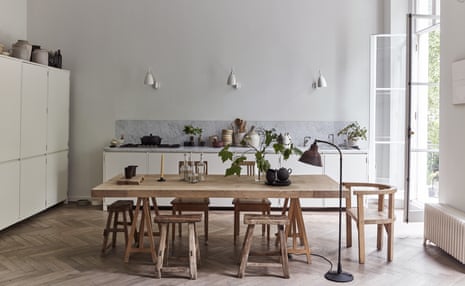
White spirit: creating a minimalist home in London
Restraint and calm are the guiding lights in this stunningly sparse apartment
F or couturier Anna Valentine , there is an overwhelming similarity between the principles behind her studio and the way she has designed her London apartment. Yet it is the sense of atmosphere at the core of this home’s refined DNA that leaves the strongest imprint. It is a graceful space, without pretence, where less is definitely more.
The first-floor Georgian apartment, which Anna shares with husband Jonathan Berger, who works in film and TV, had been untouched for 30 years when they moved in: “Despite the yellow Formica kitchen, boxy dark rooms and low false ceilings,” says Anna, “we were immediately drawn to the potential, proportions and location.”
The kitchen overlooks a private garden square, full of plane trees, and in summer the neighbourhood comes alive. Their home is just a short stroll from her studio. Anna’s love of fashion began at a young age, making clothes for her dolls while following her passion for ballet. “My mother is incredibly creative and encouraged me to sew and make – I was the original Blue Peter child,’ she says. In her early 20s, Anna turned her childhood hobby into a sideline that paid for her expensive dance classes. The door to a career in dance closed when she was 23, and fashion took centre stage.
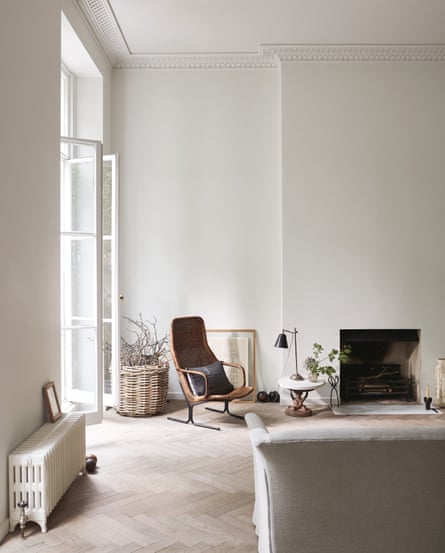
Anna learned on the job, spending hours perfecting her technique, before setting up her own couture and ready-to-wear label. Working with a team of in-house designers, pattern cutters, fitters and seamstresses, she has achieved success over the past three decades, most notably designing the wedding outfit for the Duchess of Cornwall, now Queen.
Throughout the apartment, elegant architectural bones and natural materials are given space to breathe, accentuated by furniture and collections. It is unfussy, relaxed and inviting, yet sophisticated. “We have visited Japan a few times and their wabi-sabi philosophy and view of architecture appeal to us both.” With that in mind, the couple commissioned DRDH Architects to help restore the property. “They presented paintings from the 19th-century home of Danish artist Vilhelm Hammershøi in Copenhagen. His interiors resonated with the calm, sparse style we were keen to achieve.”
alls were removed and spaces reconfigured to allow the natural light to flow through from the original, floor-to-ceiling glazed doors at the front of the apartment to the main bedroom balcony at the back. The entire two-bedroom space is united by custom-made shuttered windows, reclaimed parquet floors and intricate cornicing, commissioned from a tiny fragment of original plasterwork.

The kitchen itself has an ethereal feel, with custom-made cabinetry and marble surfaces that are echoed through similarly stark bathrooms. To balance the minimal aesthetic, an oversized cupboard conceals the more unsightly essentials of daily life. The theme continues with linking hallway cabinets and a main bedroom divide that anchors hidden storage. The tall, minimally decorated walls are painted in Farrow & Ball’s Strong White and conceal a projector and a state-of-the-art speaker system. “The negative white space encourages a wonderful interplay of light and shadow, which is very calming,” says Anna, who always considers every single detail. “I move things around until they feel just so; and it is the same with cushions, textiles and natural finds. They have to look right – squashed and lived-in, never formal. I prefer simple leaves to flowers and I’m always searching for fallen branches with beautiful shape and form.”
Furniture follows similar sculptural lines: a bespoke sofa from Studio Oliver Gustav and a dining table from Vincent Van Duysen , surrounded by antique chairs discovered in Fayence in France, as well as weathered artisanal Chinese stools from 1819 Antiques , one of the couple’s favourite antique haunts. “I often find inspiring household pieces in the UK store Freight . Usuhari glassware handblown in Tokyo by Shotoku, is also a favourite.”
after newsletter promotion
Throughout the apartment, scent is ever-present: Japanese oils on wood blocks in wardrobes and Pot Pourri Apothicaire lava rocks in the sitting room. “I don’t like scents to overwhelm, as I do perfume. With restraint, an atmosphere can be savoured and enjoyed. Our home feeds my soul,” says Anna. “It is our sanctuary and we feel blessed to live here.”
Extracted from The Art of Living with White: A Year in Inspiration by Chrissie Rucker & The White Company (Mitchell Beazley, £35; thewhitecompany.com/octopusbooks.co.uk ). Buy it for £30.80 at guardianbookshop.com
- The Observer
Most viewed
When is Eid al-Fitr 2024 and how is it celebrated?
The three-day festival celebrates the completion of the fasting month of Ramadan by Muslims across the world.

As a new moon was not sighted on Monday evening after Maghrib prayers, Muslims in Saudi Arabia and neighbouring countries will fast one more day, completing 30 days of Ramadan. The first day of Eid will then be celebrated on Wednesday, April 10.
The first day of Eid al-Fitr is determined by the sighting of the crescent moon marking the start of the month of Shawwal, the 10th month of the Islamic (Hijri) calendar.
Keep reading
A ramadan no palestinian will ever forget, the cost of a ramadan iftar meal around the world, ramadan 2024: where do your dates come from, in washington, dc: celebrating ramadan, protesting israel’s siege of gaza.
Lunar months last between 29 and 30 days so Muslims usually have to wait until the night before Eid to verify its date.
Other countries follow independent sightings.
When the sighting has been verified, Eid is declared on television, radio stations and at mosques.
![visit australia house london Muslim worshippers prepare to take part in a morning prayer on the first day of Eid al-Fitr, which marks the end of the holy fasting month of Ramadan, at the Blue Mosque in Istanbul, on April 21, 2023 [Yasin Akgul /AFP]](https://www.aljazeera.com/wp-content/uploads/2024/04/AFP__20230421__33DL38J__v1__HighRes__TurkeyReligionIslamEid-1712214656.jpg?w=770&resize=770%2C524)
How do Muslims celebrate Eid?
Traditionally, Eid is celebrated for three days as an official holiday in Muslim-majority countries. However, the number of holiday days varies by country.
Muslims begin Eid day celebrations by partaking in a prayer service that takes place shortly after dawn, followed by a short sermon.
![visit australia house london Palestinian Muslims perform the morning Eid al-Fitr prayer, marking the end of the holy fasting month of Ramadan in Gaza City on May 2, 2022 [Mahmud HAMS / AFP]](https://www.aljazeera.com/wp-content/uploads/2024/04/AFP__20220502__329C2B2__v1__HighRes__PalestinianIsraelReligionEidGaza-1712214526.jpg?w=770&resize=770%2C514)
On their way to the prayer, which is traditionally held in an open area, Muslims recite takbeerat, praising God by saying “Allahu Akbar”, meaning “God is great”.
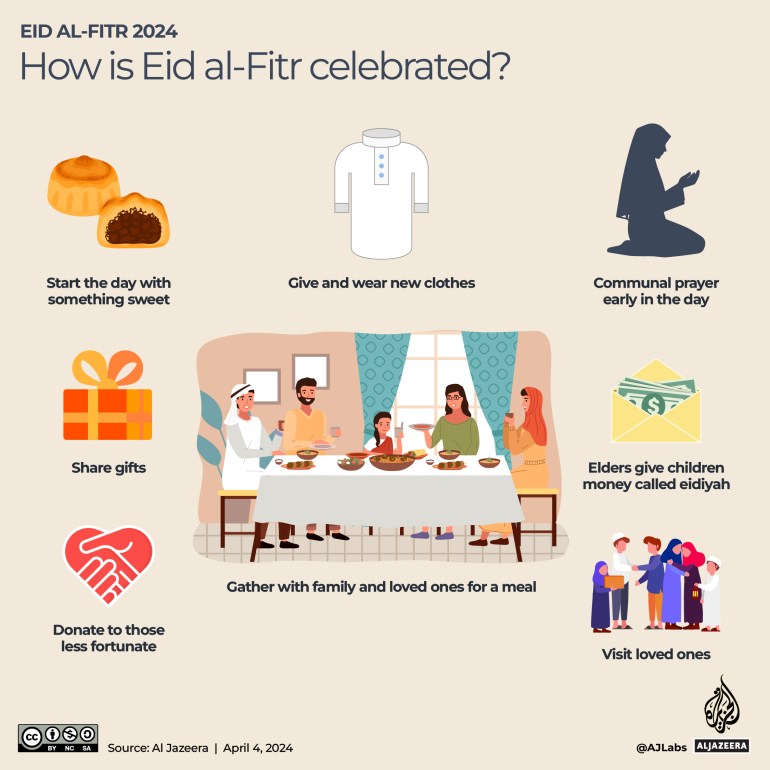
It is customary to eat something sweet before the prayer, such as date -filled biscuits known as maamoul in the Middle East. This particular festival is known as the “sweet” Eid – and the distribution of sweets is common across the Muslim world.
Muslims usually spend the day visiting relatives and neighbours and accepting sweets as they move around from house to house.
Each country has traditional desserts and sweets that are prepared before Eid or on the morning of the first day.

Children, dressed in new clothes, are offered gifts and money to celebrate the joyous occasion.
![visit australia house london Children ride a swing on the first day of Eid al-Fitr, which marks the end of the Muslim holy fasting month of Ramadan, in the rebel-held town of Maaret Misrin in Syria's northwestern Idlib province, on April 21, 2023 [Abdulaziz Ketaz / AFP]](https://www.aljazeera.com/wp-content/uploads/2024/04/AFP__20230421__33DM4EH__v2__HighRes__SyriaReligionIslamEid-1712214711.jpg?w=770&resize=770%2C513)
Girls and women in many countries decorate their hands with henna. The celebration for Eid begins the night before as women gather in neighbourhoods and large family gatherings for the application of henna.
![visit australia house london A girl shows her hand decorated with henna at a market area ahead of Eid al-Fitr, which marks the end of the Muslim holy festival of Ramadan, in Srinagar, on April 20, 2023 [Tauseef Mustafa / AFP]](https://www.aljazeera.com/wp-content/uploads/2024/04/AFP__20230420__33DJ2T3__v1__HighRes__IndiaKashmirReligionIslamEid-1712214614.jpg?w=770&resize=770%2C512)
In some countries, families visit graveyards to offer their respects to departed family members right after the morning prayers.
It is common for Muslim-majority countries to decorate their cities with lights and hold festivities to commemorate the end of the fasting month.
![visit australia house london A general view shows the Alif Ki mosque illuminated during the holy month of Ramadan, ahead of Eid al-Fitr, in Ahmedabad on April 19, 2023 [Sam Panthaky/AFP]](https://www.aljazeera.com/wp-content/uploads/2024/04/AFP__20230419__33DH2JB__v1__HighRes__IndiaReligionIslamRamadan-1712214562.jpg?w=770&resize=770%2C513)
Eid amid the onslaught in Gaza
For some 2.3 million Palestinians in Gaza this Eid, this will be the first Muslim religious holiday after more than 33,000 people have been killed in Israeli attacks. With little food aid, and very limited water, Gaza’s Eid al-Fitr will be mired in destruction amid the continuing attacks.

What are common Eid greetings?
The most popular greeting is “Eid Mubarak” (Blessed Eid) or “Eid sa’id” (Happy Eid). Eid greetings also vary depending on the country and language.
The video below shows how people say Eid Mubarak in different languages around the world.

IMAGES
VIDEO
COMMENTS
Australia House is the home of Australians in the United Kingdom. ... Australia House Strand London, WC2B 4LA United Kingdom. Phone: +44 (0) 20 7379 4334. Fax: +44 (0) 20 7240 5333. Follow us: About us. ... Visit Australia Austrade Australia.gov.au Prime Minister of Australia
The History of Australia House. Australia House is the oldest Australian diplomatic mission and it is the longest continuously occupied foreign mission in London. King George V laid the building's first foundation stone in 1913 but it was not until August 1918 that he officially opened the completed building.
The exterior of Australia House (Fig 3) is of Portland stone, on a base of light-grey trachyte from Mount Gibraltar in New South Wales. The tripartite division of rusticated lower section, rising through coupled giant-order columns, up to a strong entablature with projecting cornice, is topped with a mansard roof decorated with elaborately worked copper ridge caping and mouldings.
Please note that Australian citizens are expected to travel to Australia using an Australian passport. If you require additional information, you may telephone the Global Service Centre on +61 2 6196 0196, Monday to Friday, from 9am to 5pm your local time. International calls may be subject to charges imposed by your local carrier.
The ceremonial laying of the foundation stone of Australia House in July 1913 provided an opportunity for the simultaneous affirmation of these loyalties. Crowded with an estimated 1500 people, London's Strand was bathed in what has been frequently termed 'Australian' sunshine. Accompanied by a flourish of trumpets, the King declared the ...
Australia House on London's Strand is celebrating it's 100th anniversary this year Credit: John Nguyen The panelled walls are further embellished by carvings of laurel wreaths and wattle ...
Broadcast Thu 6 Dec 2018 at 10:10pm. Listen. 6m. The Exhibition Hall at Australia House London (Photo: Facebook (Australia High Commission in the United Kingdom)) A hundred years since the end of ...
First published in The Age on August 5, 1918. AUSTRALIA HOUSE. OPENED BY THE KING. AN ELABORATE CEREMONY. London, 3rd August. Australia House in London in 1935. The King opened Australia House ...
The Prosperity of Australia, Australia House, by Harold Parker (1915-1918) The High Commission of Australia in London is the diplomatic mission of Australia in the United Kingdom. [1] It is located in Australia House, a Grade II listed building. [2] It was Australia's first diplomatic mission and is the longest continuously occupied diplomatic ...
The story begins in the late 1960s and 70s, in the wake of two seismic shocks to the national strategic imagination: Britain's impending entry into the EEC and its decision to draw down its military presence in Southeast Asia. Accordingly, Australian politicians and policymakers began the process of putting the relationship with Britain on a ...
Victoria House was built in 1907 on the corner of Aldwych and the Strand and west of Melbourne Place. The land was abandoned and unkept for many years before the Australian Government acquired the freehold in the heart of London. The land cost the Australian people £379, 756 and the overall cost of the building and other associated expenses ...
Completed in 1918, Australia House is a lavish building, which is steeped in history, and the home of our oldest diplomatic mission. Described in 1930 by one journalist as the "national foyer", it's been much more than an embassy for many of its 100 years, once housing banking facilities, a poste restante, an information counter, a cafeteria and a reading room.
Travel advice. To help Australians avoid difficulties overseas, we maintain travel advisories for more than 170 destinations. Smartraveller - travel advice ... Australia House The Strand London WC 2B 4LA United Kingdom. Telephone +44 20 7379 4334. Fax +44 20 7887 5558. Website. Australian High Commission in United Kingdom website.
The United Kingdom is one of our most like-minded partners in the world. Fast Facts. UK visitors to Australia (June 2019) — 718,600. Australian visitors to UK (June 2019.) — 667 800. Resident Australian population born in UK (2016 census) — 907,570. Australian residents of UK ancestry (2016 census) — 7.85 million.
It is the oldest continually-occupied diplomatic building in London and it was the first major public building of the new Commonwealth of Australia. The day King George V opened Australia House, on 3 rd August 1918, the Exhibition Hall, was filled with distinguished guests to mark the significance of the occasion. Taking pride of place among ...
London's Australia House usually dishes out travel documents and advice but could also in theory provide entirely drinkable water from an ancient well underneath, according to laboratory tests.
Notably, Australia House was the first purpose-built diplomatic building in London. Work began in 1913, and Australia House was officially opened on 3 August 1918. The completed building features wood and marble shipped from Australia and sculptures carved by an Australian artist, Harold Parker.
1300 555 135 from within Australia; Services. Visas, Migration and Citizenship . ... Australia House Strand London, WC2B 4LA United Kingdom. Phone: +44 (0) 20 7379 4334. Fax: +44 (0) 20 7240 5333. Follow us: ... Visit Australia Austrade Australia.gov.au Prime Minister of Australia
The Australia Embassy in London is open to the public for the purpose of attaining visas to visit Australia. ... Australia House, The Strand, London WC2B 4LA Phone: (020) 7379 4334 www.australia.org.uk. Ireland: Australian Embassy, Fitzwilton House, Wilton Terrace, Dublin Phone: (01) 6761517
Australia House is the Australian Embassy that serves the UK and is based in London at Australia House, Strand, London WC2B 4LA. While the Australian Embassy provides diplomatic and consular services to Australians in the UK and Ireland, the majority of visa applications do NOT require the individual to visit the Embassy in person.
Book your Australia House, London tickets online and skip-the-line! Save time and money with our best price guarantee make the most of your visit to London! ... he interacted with all the guests and went the extra mile to answer questions and recomend some plaes to visit in London. I definitely recomend the Harry Potter walk. Read more. ...
Book your Australia House, London tickets online and skip-the-line! Save time and money with our best price guarantee make the most of your visit to London! ... Travel from Birmingham New Street to Watford Junction in under 90-minutes en route to Warner Bros. Studio in London. Visit the studios which opened in 2012, and is the only location in ...
The Beatles visit to Australia House in London, April 22, 19640:27 The Beatles entertained at a reception at Australia House in London - Sir Eric Harrison (...
Working with a team of in-house designers, pattern cutters, fitters and seamstresses, she has achieved success over the past three decades, most notably designing the wedding outfit for the ...
As a new moon was not sighted on Monday evening after Maghrib prayers, Muslims in Saudi Arabia and neighbouring countries will fast one more day, completing 30 days of Ramadan. The first day of ...